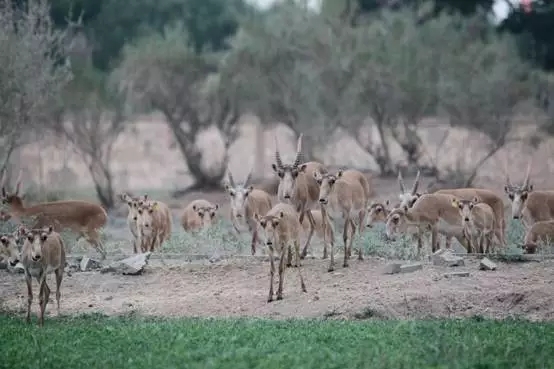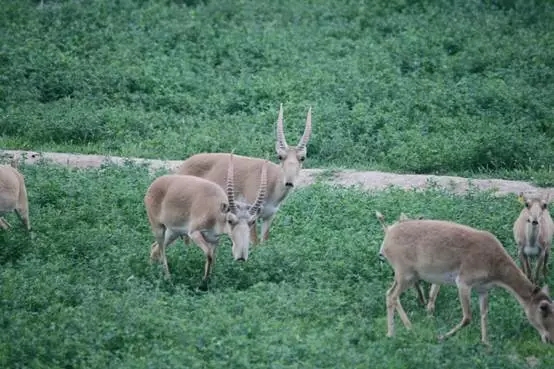
Saiga Antelope (Photo from internet, Public domain copy right)
Once millions of Saiga antelope, also called Saiga, roam between their winter and summer ranges on the vast Eurasia steppe. The mass herds of Saiga on move are spectacular on the Eurasia steppe. Some of the Saiga also migrated to Xinjiang, China. The Saiga covered with cinnamon colored wools with pale color under bully and neck in summer and their wool changed to light brawn with very thick under-wools during the winters. Saiga has a large humped nose which is flexible and inflatable so helps it to warm air during cold winters to filter air during dusty summers. Saiga has a pair of thick, amber-colored and semi- translucent horns. Saiga horn has been used in traditional medicine. Records of the use of Saiga horns in the traditional Chinese medicine prescriptions can be traced back to 2,000 years ago.

Saiga antelope on the vast Eurasia steppe(Photo from internet)
In the 1950s, Saiga populations declined rapidly to extinction in China due to overhunting, habitat reduction and blockage of migratory routes. In order to restore the species, the Wuwei Endangered Wildlife Breeding Centre (WEWBC, now called Gansu Endangered Animal Protection Centre) was established in Gansu Province, China in 1987. The Saiga in Kazakhstan and Russia also decreased 90% in 20 years; consequently, Saiga has been listed in Appendix of Convention on International Trade of Endangered Species of Wild Fauna and Flora (CITES), UN Convention on Migratory Species (CMS) and listed as the first category of National Key Protected Wild Animal Species in China.
Eleven adult Saiga from the San Diego Zoo and the Berlin Taie Zoo were introduced to form the founder herd during 1988–1991, and one calf was added from the wild Saiga population in Kalmykia, Russia in 1997. Currently, the population at WEWBC has increased to over 170 individuals. However, founder events, bottlenecks and inbreeding have resulted in low genetic diversity in this captive population, which, together with harsh winter conditions and epidemic disease, has led to large fluctuations in the population size. The number of Saiga at WEWBC once decreased by 77%, only nine individuals survived in the year of 2000. However, so far no further reintroduction of Saiga has been taken.

Saiga in the Wuwei Endangered Wildlife Breeding Centre (Photo by Jiang Zhigang)
Before a reintroduction programme is planned and execution implemented, an assessment of historical distribution patterns and potential reintroduction sites is necessary. However, compared with other regions in Central Asia, virtually no study has explicitly examined the former Saiga range in China or developed a timeline of its decline. Also, no studies have been done to determine how historical Saiga populations moved seasonally between China and its neighbouring countries, and whether the current habitat conditions can sustain reintroduced populations.

Saiga in the Wuwei Endangered Wildlife Breeding Centre (Photo by Jiang Zhigang)
In a paper published in Scientific Reports in 2017, scientists from the Institute of Zoology, Chinese Academy of Sciences, in cooperation with scientists from the Oxford University delineated the historical distribution and potential reintroduction areas of Saiga in China, using a literature review, interviews and predictive modelling. They found a total of 28 historical records, which covered the time period from the end of the 19th century to the 1950s.
However, WEWBC is outside the historical range of Saiga; it is not an ideal reintroduction site for revival Saiga due to its low habitat suitability and the difference in environmental variables. The results demonstrate the challenges of restoring a free-ranging, sustaining Saiga population. They recommend reintroduce Saiga to the protected areas within the potential Saiga range in northern Xinjiang and developing a national action plan to provide a framework for the future recovery of the species.
Note: You can access the full article published in the journal Scientific Reports at: http://www.nature.com/articles/srep44200
Contact:
Jiang Zhigang
Institute of Zoology, Chinese Academy of Sciences (http://english.ioz.cas.cn/)
Chaoyang District, Beijing 100101, P.R.China
Email: jiangzg@ioz.ac.cn




